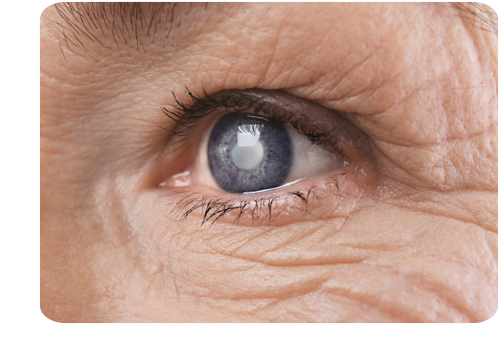What is cataracts?
Cataracts are a very common eye disease, especially in people over 60 years of age. Since cataracts are mostly age-related, they are also called age cataracts. A clouding of the lens leads to impaired vision as the disease progresses. In the meantime, however, this eye disease can be treated very well thanks to modern medicine.

What are the causes of cataracts?
Cataracts are primarily an age-related change in the lens of the eye. However, the disease can also be triggered by the following factors:
- Metabolic diseases (e.g. diabetes)
- Age
- Smoking
- Genetic predisposition
- Concomitant disease in hereditary diseases
- Injuries to the eye
- Previous severe inflammation of the eye
- Nutrient deficiencies
- Medication (e.g. cortisone)
- Strong exposure to light / UV radiation
- Severe myopia

What are the symptoms of cataracts?
Affected people initially complain of a greater sensitivity to glare when they are exposed to light sources. The progressive clouding of the lens results in a loss of contrast. Colors are perceived as paler or duller and light-dark adjustment is worse Spatial perception is then often restricted. Close-up vision, such as reading, and driving in the dark are becoming increasingly problematic – depending on the progression of the cataract. Those affected therefore feel increasingly restricted in their everyday lives.
Cataracts: treatment with multifocal lenses
Modern medicine now makes it possible to treat cataracts in the long term: artificial lenses replace the clouded natural lens and thus eliminate the cataract.
Various types of lenses are used for cataract surgery: The monofocal lens, with one focal point, enables clear vision at a distance, usually in the distance. In most cases, those affected are therefore not completely exempt from glasses and they still need reading glasses.
Modern premium lenses, so-called multifocal lenses, enable the patient to live without glasses as far as possible. Because this type of artificial lens, thanks to several focal points, ensures vision at all distances – in the near, intermediate and far range.

The multifocal lens treatment to correct cataracts is performed on an outpatient basis and takes about 10 minutes per eye. Anesthesia is not necessary. Anesthetic eye drops are completely sufficient for a painless treatment.
In the group of companies, our doctors have already performed more than 210,000 lens treatments. Thanks to the experience from many treatments and regular further training, our patients are in the best hands with the CARE Vision experts.
Cataract treatment schedule
The treatment consists of an initial non-binding information meeting, if desired together with a detailed preliminary medical examination, the lens treatment and several follow-up examinations.
It is very important to us that our patients feel they are in good hands, safe and fully informed at all times.
Personal consultation and preliminary medical examination
In an initial personal consultation, we will inform you about the possibilities of lens treatment and comprehensively answer all your questions. The first characteristics of the eye are recorded and checked to determine whether it is suitable for multifocal lens treatment.
During the preliminary medical examination, your eyes will be precisely measured by an experienced ophthalmologist. If the patient is suitable for multifocal lens treatment, the doctor treating you will provide comprehensive information about the course of treatment and will answer any questions the patient may have.
Cataract treatment with multifocal lens
On the day of the outpatient treatment, the eye to be treated is numbed with drops to ensure pain-free treatment. Then the actual lens exchange begins. Through a tiny incision at the edge of the cornea, the natural, clouded lens is removed with the help of a phaco device and the new modern multifocal lens is inserted. This takes no more than 10 minutes per eye. If both eyes are treated, this is usually done on two consecutive days.
The comprehensive aftercare
In the first three months after treatment, the patient attends several follow-up appointments and follows a drop schedule. The multifocal lenses are not noticeable in the eye from day one and can usually remain in the eye for a lifetime.
Cataract surgery:
cost of treatment
A lens implantation with multifocal lenses for the treatment of cataracts amounts to approx. €2,800 per eye. This cost includes the treatment, which includes a high-quality multifocal lens and follow-up examinations. We are happy to offer you flexible financing of the treatment costs on request. Billing takes place according to GOÄ after the treatment has been completed.
Frequently asked questions about cataracts (FAQ)
With cataracts, you notice increased glare sensitivity and a loss of contrast. You see as if through a veil, which means that colors are perceived as pale, spatial perception and light-dark adjustment are worse. Reading and seeing at close range is becoming increasingly difficult. Cataracts usually appear after the age of 65.
Cataracts are not life-threatening, but they can have a major impact on everyday life. In the worst case, it leads to blindness.
There is no maximum age for cataract treatment. An operation always makes sense, even at an advanced age, as it enormously improves the quality of life of those affected.
No. First one eye is operated on and on one of the following days the second.
No. The procedure is performed under local anesthesia of the eyes and is therefore usually painless.
You should have cataracts treated if your vision is restricted by the disease and it is a burden to you in everyday life. The treatment can be carried out at any age.
The treatment takes no more than 10 minutes per eye. If both eyes are treated, this is usually done on two consecutive days.
Normally, you can go back to your everyday life the day after the treatment. However, we recommend our patients to rest for a few days in order to get used to the new, significantly improved visual impression.
Statutory health insurance companies usually only cover the costs of treating cataracts with monofocal lenses. These lenses have only one focal point and therefore only enable sharp vision at a distance (usually far away). Glasses are still required to see at other distances.
The modern lens is not noticeable in the eye. After 2-3 days you should feel better vision.
The patient will not feel any difference. Where the natural lens used to be, the artificial lens has now taken its place. The premium lenses are also not visible.
No, the material has been used on the eye for many decades, is absolutely biocompatible and thanks to extensive preliminary examinations, it is ensured that the eye is suitable for multifocal lens treatment. Complications after the operation are therefore generally not to be expected. The comprehensive follow-up examinations and the drop plan, which the patient must follow exactly after the treatment, also prevent this.
